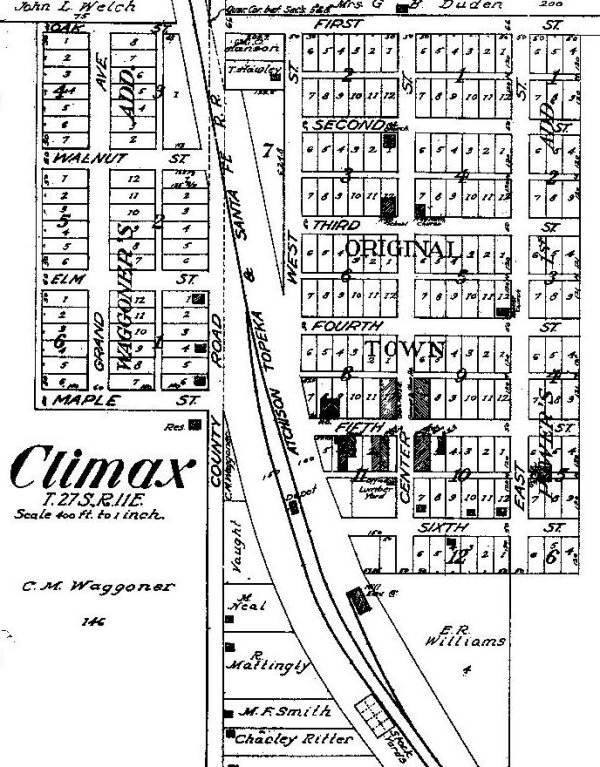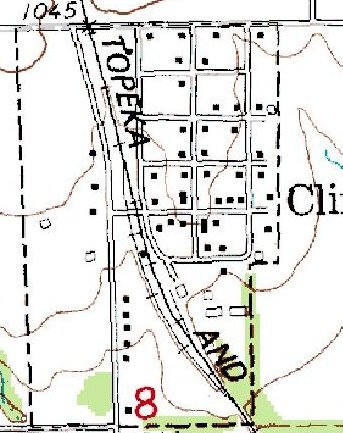Howard Branch: Climax |
|
Climax, 1903 and 1990. Climax had the House track and the elevator Spur switch on South End. Climax was the childhood home of James Burke, so many photos appear in his books. In 1945, 12 year old Jimmy Burke lived in Climax. Climax was a thriving community of 100 people (depending on where you stopped counting) and boasted two grocery (general) stores, a hardware store, blacksmith's shop, two filling stations, a creamery, barber shop (25¢), post office, grade school and high school, and three churches. The railroad track was very simple: mainline, house track which served the stockyard, and a spur to the grain elevator. James Burke was the unofficial yardmaster and he kept an account of every car that was spotted in Climax during the first 10 months of 1945. That record is attached. This invaluable account shows the high level of rail activity in small towns in 1945. Climax had two trains a day: 95 and 96. 96 left Emporia and terminated in Moline. 95 had a busier schedule, starting at Moline and moving north to Madison Jct. where it then traveled to Virgil before returning to Madison and terminating in Emporia. They met somewhere along the branch, often at Climax or Eureka. After December 1948, the service became a turn with one engine making the round trip. There were 236 cars spotted in Climax in those 10 months. 246 trains, or 45% of the trains that went through, had some work to do in Climax. 75% of the traffic came out of Emporia. Only 44% returned north, and most of this (30% of all cars) were headed to Small. A chart is attached which gives some details about these cars. Most came from the north on 96, and elevator traffic was easily spotted as a trailing move. Cars coming in on 95 from Moline were either 1) placed on the house track and using a run around move spotted at the elevator, 2) run into the south end of the house track using a flying switch (the house track was longer than the elevator track, making this move safer), or 3) left on the house track for 96 to spot later. 96 usually had more time to work the line and more capacity. By the time 95 got out of Moline they were late and loaded. The engines and crew used for 95 frequently had to work Crusher before they could leave for Emporia. Burke remembers the house track as 90# rail, while the elevator had 60# rail. All loads leaving the elevator went south on 96 to Moline. From there they could go east to Chanute and Kansas City, west or south through Arkansas City and Wellington, or return north to Emporia on 95. Of the 236 cars, 112 or 47% were ATSF cars. The balance came from 40 different lines. The C&O, MILW, B&O, and PRR were the most common in order, providing 10, 9, or 8 cars each. Western lines were sparsely represented. Auto box and regular boxcars made up 147 of the cars, or 62%. Gondolas were next with 33 cars, 30 of which were ATSF. Coal was delivered in 4 of the off line gondolas. Stock cars made up 30 of the deliveries, 29 of which were ATSF. 6 ATSF reefers and 18 cars in MOW service make up the balance. "Other than cattle and coal, Climax didn't receive much. Miscellaneous merchandise came by Santa Fe Trailways truck that came down from Emporia a couple of times a week. Towns like Eureka that had farm implement stores off-loaded carloads of farm machinery occasionally, but Climax had no such stores or off-loading dock. The meat reefer unloaded LCL meat one day each week and returned to Emporia the next day. But times had changed. When my Dad arrived in Climax in 1903, the family unloaded a carload of household goods at the old pre-1912 Climax Depot." Burke. Depot
The climax depot was an ATSF Branchline Standard #2. Click here for more photos and plans. These can be found in Santa Fe System Standards, Vol. 2. Plans and photos can also be found in Frank Ellington's, Santa Fe Depots of the Plains. The depot was purchased and has been moved near Cedar Point, KS, but has not been restored as of 2012. It was to be part of a theme park which was never developed. The stock pens were on the house track and had 7 car capacity, 4 pens and a pump. Elevator The Climax grain elevator was a landmark; only about 20' remains due to a destructive fire in October 2001. It was originally the Arnold and Colyer Grain Company. It was purchased by Sowder in the 1950s, the same folks who owned the elevator on the Santa Fe tracks in Eureka. It could accept covered hoppers. Most loads moved on the 96 to Moline. This elevator was 28' wide and stood 50' high. In its later days, the exterior was covered with vertical corregated sheet metal in 2' wide panels. The horizontal stay bolt ridges were 5 feet apart. Click here for more photos. Just north of Climax was one of the scenic spots as the track crossed the Honey Creek Bridge.
|









